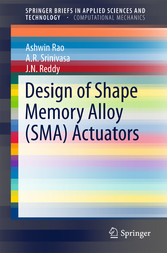Suchen und Finden
Service
Design of Shape Memory Alloy (SMA) Actuators
Ashwin Rao, A. R. Srinivasa, J. N. Reddy
Verlag Springer-Verlag, 2015
ISBN 9783319031880 , 137 Seiten
Format PDF, OL
Kopierschutz Wasserzeichen
Geräte
Preface
7
Acknowledgments
9
Contents
10
1 Introduction to Shape Memory Alloys
13
1.1 Smart Materials--An Overview
13
1.2 Smart Structures---System Level Response
14
1.3 Shape Memory Alloys: Temperature Induced Phase Transformations
17
1.4 Shape Memory Effect and Superelasticity/Pseudoelasticity
20
1.5 Commonly Used Shape Memory Alloys
24
1.6 SMA Applications: Overview
27
1.6.1 Biomedical Applications
27
1.6.2 Civil Engineering Applications
31
1.6.3 Aerospace and Automotive Applications
35
1.6.4 Miscellaneous Applications
37
1.7 Chapter Summary
39
References
40
2 Need and Functionality Analysis
44
2.1 The System Design Process
46
2.1.1 Design Methodology: Structure and Guidelines
47
2.2 The Five Major Subsystems
49
2.3 How Do We Identify Need and Functionality for SMAs
51
References
52
3 Manufacturing and Post Treatment of SMA Components
53
3.1 Different Manufacturing Techniques
53
3.1.1 Vacuum Induction Melting (VIM) Technique
54
3.1.2 Vacuum Arc Remelting (VAR) Technique
55
3.1.3 Electronic Beam Melting (EBM) Technique
56
3.1.4 Conventional/Normal Sintering Technique
56
3.1.5 Selective Laser Sintering (SLS)
57
3.1.6 Hot Isotactic Pressing (HIP)
57
3.1.7 Spark Plasma Sintering (SPS)
57
3.1.8 Selective Laser Melting (SLM)
58
3.1.9 Metal Injection Molding (MLM)
59
3.2 Post Treatment of SMAs
59
3.2.1 Machining of SMA Components
60
3.2.2 Surface Treatment of SMA Components
60
3.2.3 Annealing and Coldworking of SMA
62
3.2.4 Joining of SMA to Itself and Other Materials Like Stainless Steel
63
3.2.5 Shape Setting of Nitinol
65
References
69
4 Basic SMA Component Geometries and Responses
71
4.1 SMA Wire Response---Tensile Loading
71
4.2 SMA Wire Response---Torsional Loading
75
4.3 SMA Spring Response---Torsional Loading
77
References
81
5 Factors Influencing Design of SMA Actuators
82
5.1 Geometry Factors
82
5.2 Effect of Alloy Composition
84
5.3 Effect of Shape Setting Conditions for Custom Shape (Making SMA Springs)
85
5.4 Effect of Operating Temperature on Mechanical Response
85
5.5 Effect of Loading Rates
86
5.6 Wire Training/Hysteresis Stabilization
87
References
88
6 Graphical Description of Temperature Controlled Actuation of SMA Wires
90
6.1 SMA Wire + Bias Spring Arrangement
90
6.1.1 SMA Wire Selection
90
6.1.2 Operating Temperature of SMA Wire
92
6.2 Graphical Design Approach for Stroke Estimation
92
6.2.1 Graphical Design Approach for Stroke Estimation---Load and Displacement Controlled Tests
94
6.2.2 SMA Wire + Bias Spring: Graphical Design Approach for Stroke Estimation Using Linearized Loading Response only
96
6.3 Case Study 2: Linear to Rotary Arrangement Using a SMA Wire + Bias Spring Arrangement Using Linearized Loading Response Only
97
6.4 Case Study 3: SMA Wire + Bias Spring Arrangement Using Linearized Loading---Unloading Response
102
6.5 Case Study 4: SMA Wire + Bias Spring Arrangement ƒ
105
References
106
7 Case Studies in the Preliminary Design of SMA Actuators
107
7.1 Different Modes of Operation
109
7.1.1 Constant Force Mode
109
7.1.2 Constant Deflection Mode
110
7.1.3 Simultaneous Force-Deflection Mode
110
7.2 Design of SMA Wires Under Constant Force
111
7.3 Case Study II: Design Procedure for Ti--Ni (SMA) Springs
113
7.4 Spring Design Case Study
113
7.4.1 Design Model and Assumptions
113
7.4.2 Terms Used in Design of SMA Springs
115
7.5 Example: Design of a Remote Controlled Flow Control Valve Using an SMA
116
7.5.1 Statement of Requirement
116
7.6 Extensional Spring Design
120
7.7 Heating and Cooling of Shape Memory Wires
121
7.7.1 Time Taken to Heat Up and Cool Down
122
References
123
8 Coupling SMA Actuators with Mechanisms: Principle of Virtual Work
124
8.1 The Need for Mechanisms
124
8.2 The Loading Curve and the SMA Response
127
8.3 3-D Design
130
8.4 Bias Forces
131
Reference
131
9 Fatigue of SMAs
132
9.1 Structural and Functional Fatigue in SMAs
132
9.2 Reporting Fatigue Data
135
References
136
Service
Shop



